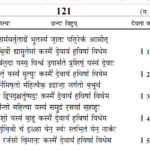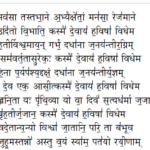SRI GURUBHYO NAMAH
Tvameva = you only; Kevalam = only;
Kartaasi= are the doer;
tvameva = you only;
Kevalam = only;
dhartaasi = are the bearer or support;
tvamEva = you are;
Kevalam = only;
Hartasi= are the usurper;
TvamEva = you only;
sarvam = all, entire;
Khalu = indeed;
idam = this;
brahmaasi = are Brahma;
tvam = you;
saakshaat = before the eyes.Atmaa = the individual self or soul;
asi = are;
Nityam= ever.
Tvameva kevalam Kartaasi, TvamEva kEvalam dhartaasi tvameva Kevelam hartaasi, Tvameva Sarvam khalvidam ( Khalu idam) Brahmasi Tvam Saakshaadaatmasi Nityam
I bow to you, Ganapati. You being the creator, protector and destroyer of the Universe, the Brahman, you are none other than Brahman, you are indeed Brahman. You are the in-dweller eternal evident “Self” in all of us. This portion of the Upanishad reconfirmed that Atman the SELF is Brahman.
Shrutis’s say that the nameless & formless Brahman only existed before the creation. The whole universe was inside THIS which has no name and form for having dissolved the Universe into it during annihilation called Tirodhana.
How THIS Brahman has created the Universe or manifested ( Prakata golluvudu) as Universe.
Sukta 121 in 10 th Mandala of Rigveda called Hiranyagarbha Sukta gives description. Hiranya Garbha Sukta is also found in Yajurveda with a little variation.This sukta is used in Mahanyasa for performing Sashtannga Namaskara.
‘Hiranyagarbha’ means ‘the golden womb from which all powers manifest’. RV (10.121) has ten mantras. The 10 th mantra specifically indicates that Prajapati is the Creator. Prajapati is Brahman…
+`
10.121.1: In the beginning (agre) arose the golden seed born, he was the sole lord of every creature He upheld this earth and heaven. We shall worship this KaH form of divine. Ka brahma kha brahma is the Upanishad vakya. Sayana in his bhashya has given many more meaning for Kah including the happiness. Kasmai also means that the Brahman is the one who cannot be easily known.
hiranya: the common meaning is gold. But hi stands for hita, ‘placed’ or ‘hidden and ranya means ‘delight* in many RV mantras. Hence hiranya is that ‘in which the delight is hidden*. It is the concrete image of the higher light, the gold of the Truth. Gold is the symbolic colour of the light of the Sun. kah: the pronoun ‘who’; Prajapati. Many translations of line kasmai devaya havisha vidhema read, ‘who is the deity we shall worship?’, reflecting a doubt. We worship the Brahman who is in the form of Kah seems to be correct.
10.121.2: It is he, the Brahman who bestows the soul-force (atmada) and vigour upon his bidding (prashisha) all, even the Gods, approach (him) with worship (upasate) (2); his shadow is immortality and death is also his (shadow) (3). We worship that kasmai Deva -the Brahman
10.121.3: He alone became by his greatness (mahitva), the sole (eka) king of the breathing and seeing in this dynamic universe jagatah) (l). He is the lord of all beings with two states (of consciousness) (dvipade) and four states (of consciousness) (chatushpade) (2).
[dvipade: two states such as giving and taking; matter and mind; here and hereafter etc.] This also means Humans and animals with four legs. We worship that kasmai Deva -the Brahman
.
10.121.4: These snowy mountains (arose) through his greatness (mahitva) (1). They call the oceans and their essence (rasa) as his (2). These quarters are his arms (3). We worship that kasmai Deva -the Brahman
.
10.121.5: It is He, through whom the heaven is forceful (ugra) and the earth firm (l); by him the world of Light (suvah Loka) and the heaven (naka) were supported (or propped) (2). He is the measurer (vimana) of the region of the midworld (3); We worship that kasmai Deva -the Brahman
10.121.6: (The Heaven and Earth) which sound their thanks (krandasl) to him (yam, Prajapati) for his propping them up (tastabhane) and for his protection (1), and they look upto him gratefully by their illumined (rejamana) minds (2), while the sun, rising, brightly shines over them (3). We worship that kasmai Deva -the Brahman
10.121.7: When the mighty waters (energies) enveloped the universe (vishvam) (1), bearing the child in birth (garbha) and gave birth to Agni (2), then (Prajapati), the sole breath of the Gods, arose (samavartata) (3). We worship that kasmai Deva -the Brahman
..
10.121.8: He in his might beheld the energies (waters) (1), bearing the discernment (daksha) and gave birth to yajna (2). He was the sole God above (adhi) all the Gods (3). We worship that kasmai Deva -the Brahman
10.121.9: May he who is the father of earth protect us (1). He created the heaven, his law of being is Truth (2). He created the great delightful Waters (3). We worship that kasmai Deva -the Brahman
[line 1: ma no himsit: may no harm come to us, i.e., may we be protected.
10.121.10: O Prajapati, none other than you have given existence to all these beings (2). That object of our desires for which we call you (3), may that be ours (4). May we become the masters of felicities (5)?10
Following Upanishad vakyas also speak about Hiranya Garbha
Isa Upanishad: Chapter I: Verse 12-14
Svetasvatara Upanishad: Chapter: III: Verse 4
Svetasvatara Upanishad: Chapter: III: Verse 7
Svetasvatara Upanishad: Chapter: V: Verse 2
Svetasvatara Upanishad: Chapter: IV: Verse 2 & 12
Brihadaranyaka Upanishad: Part One: Chapter 2, 3, 5
Brihadaranyaka Upanishad: Part Two and Four
Brihadaranyaka Upanishad: Part Three: Chapter VI: 9
Brihadaranyaka Upanishad: Part Four: Chapter III & 5
Mundaka Upanishad: Part One: First Mundaka: Chapter II
Taittiriya Aranyaka also explains how the universe was created


No responses yet